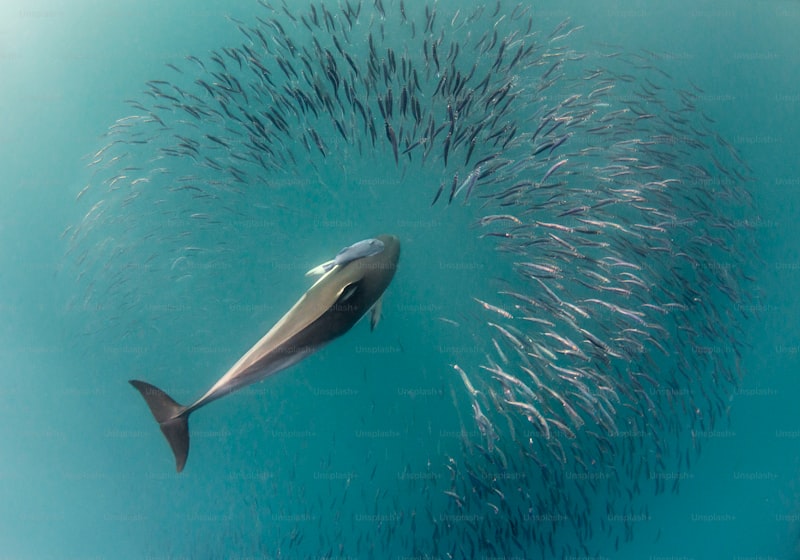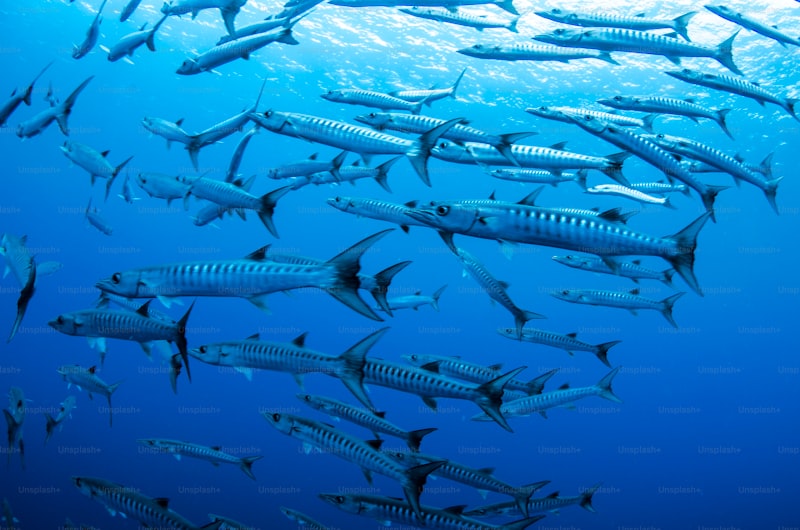Have you ever wondered what creatures lurk beneath the waves, ruling the depths with stealth and prowess? Oceanic predators are the apex hunters of the sea, perfectly adapted to their environment in ways that both fascinate and intimidate. From the mighty orca to the elusive great white shark, these creatures command respect and embody the raw power of nature’s food chain.
One of the most iconic oceanic predators is the orca, also known as the killer whale. Despite its name, the orca is actually a member of the dolphin family. Don’t let its friendly cousin fool you, though—the orca is a formidable predator with a diverse diet that includes fish, seals, and even whales. Known for their intelligence and complex social structures, orcas hunt cooperatively, strategizing to corner their prey with unparalleled precision.
Moving down the food chain but no less fearsome is the great white shark. Made famous by Hollywood and feared by beachgoers worldwide, this shark is the ultimate predator of the open ocean. With powerful jaws lined with rows of serrated teeth, the great white strikes with astonishing speed and force, often breaching the surface in pursuit of seals and fish. Its keen sense of smell allows it to detect blood in the water from miles away, making it a relentless hunter in its domain.
Delving deeper into the ocean’s mysteries, we encounter the colossal squid—a creature of legend that prowls the depths where sunlight can barely penetrate. With eyes the size of dinner plates and tentacles armed with powerful suction cups and swiveling hooks, the colossal squid is a master of ambush. Its ability to blend into the darkness and strike with precision makes it a nightmare for deep-sea prey.
Unveiling the Sea’s Apex Predators: Oceanic Hunters in Action
Picture this: a Great White Shark gliding effortlessly through the water, its streamlined body slicing through the waves with remarkable agility. With rows of razor-sharp teeth and a keen sense of smell, it lurks beneath the surface, a true master of stealth and ambush. These apex predators are not just hunters but symbols of nature’s perfect design, evolved over millions of years to reign supreme in their domain.
But it’s not just about size and strength. Take the Orca, often called the “killer whale,” for example. Despite its name, the Orca is a highly intelligent and social predator, known for its cooperative hunting techniques. These whales work together in pods, communicating through intricate vocalizations and tail slaps to corner their prey. They are not only formidable hunters but also showcase a level of intelligence and teamwork rarely seen in the animal kingdom.
The oceanic ecosystem relies on these apex predators to maintain balance and health. By preying on weaker or sick individuals, they prevent disease and overpopulation among their prey species, ensuring a robust and resilient marine environment.
From the graceful movements of the Bluefin Tuna to the lightning-fast strikes of the Swordfish, each apex predator plays a crucial role in the intricate web of life beneath the waves. Their presence is not just a testament to nature’s power but a reminder of the delicate balance that sustains our oceans.
As we delve deeper into the mysteries of the sea, we uncover more about these oceanic hunters and their remarkable abilities. They inspire awe and fascination, capturing our imagination with every breach, every hunt, and every display of raw natural prowess.
Masters of the Deep: Meet the Most Formidable Ocean Predators
The great white shark, with its iconic silhouette and powerful jaws lined with rows of serrated teeth, strikes a balance between grace and sheer ferocity. Known for its ability to breach the surface in pursuit of prey, this oceanic giant instills awe wherever it roams. Its presence alone can send shivers down the spine of even the most seasoned marine biologist.
Contrasting the solitary nature of the great white is the orca, also known as the killer whale. Despite the misleading name, orcas are not whales but rather the largest species of dolphin. They hunt in highly coordinated pods, using sophisticated strategies to target and capture prey such as seals, fish, and even other whales. Their intelligence and adaptability make them one of the ocean’s most successful predators.
Delving deeper into the ocean’s depths, we encounter the elusive giant squid, a creature of myth and legend. With eyes the size of dinner plates and tentacles armed with suction cups lined with sharp hooks, the giant squid is a master of stealth and ambush. It lurks in the darkness, preying on fish and other cephalopods with lightning-fast strikes.
Beyond these renowned predators, the ocean harbors countless other species adapted for survival in its unforgiving environment. From the lightning-quick barracuda to the stealthy ambush of the moray eel, each creature plays a vital role in maintaining the delicate balance of marine ecosystems.
As we continue to explore and study these masters of the deep, one thing remains clear: their ability to adapt and thrive in the ever-changing seascape is a testament to the wonders and mysteries of the world beneath the waves.
From Sharks to Killer Whales: Exploring the Top Predators of the Ocean
Sharks are perhaps the most iconic predators in the ocean, known for their sleek bodies, powerful jaws, and keen sense of smell. With over 400 species ranging from the massive great white shark to the agile hammerhead, these predators have adapted over millions of years to hunt efficiently in diverse marine environments. Their sharp teeth and incredible speed make them formidable hunters, capable of taking down prey much larger than themselves. Sharks are essential in regulating prey populations, ensuring the health of ocean ecosystems.
Often referred to as “killer whales,” orcas are actually members of the dolphin family and hold the title of apex predators in the ocean. These highly intelligent mammals are known for their complex social structures and sophisticated hunting techniques. Orcas hunt in pods, working together to corral and isolate prey such as fish, seals, and even whales. Their distinctive black and white coloring and large dorsal fins make them easily recognizable. Orcas are found in all oceans, from the icy waters of Antarctica to the tropical seas, showcasing their adaptability and dominance in various habitats.

Both sharks and killer whales have evolved remarkable adaptations that contribute to their success as apex predators. Sharks have electroreceptors called ampullae of Lorenzini, which detect electrical signals emitted by prey, helping them locate hidden prey such as fish buried in sand. Their streamlined bodies reduce drag, enabling swift movements through water. Orcas, on the other hand, possess excellent communication skills within their pods, allowing for coordinated attacks on prey. Their intelligence and ability to learn new hunting techniques have contributed to their widespread distribution and formidable reputation as ocean hunters.
Despite their importance in marine ecosystems, both sharks and killer whales face significant conservation challenges today. Overfishing, habitat loss, pollution, and climate change threaten their populations worldwide. Conservation efforts aim to protect these species and their habitats, ensuring future generations can continue to marvel at these magnificent ocean predators.
The ocean’s top predators, from sharks to killer whales, embody the awe-inspiring power and diversity of marine life. Their unique adaptations and hunting strategies have shaped ocean ecosystems for millions of years, highlighting their crucial role in maintaining balance and biodiversity. As we strive to protect our oceans, understanding and appreciating these apex predators is essential for their conservation and the health of our planet’s most extensive ecosystem.
Survival of the Fittest: How Oceanic Predators Maintain Their Dominance
Take the great white shark, for instance. With its torpedo-shaped body and rows of razor-sharp teeth, it’s the epitome of oceanic prowess. Every aspect of its anatomy, from its keen senses to its powerful jaws, is finely tuned for hunting. When it breaches the surface, dorsal fin slicing through the waves, it strikes fear into the hearts of its prey.
Then there’s the orca, known as the wolf of the sea. Highly intelligent and social, orcas hunt cooperatively, strategizing and communicating with remarkable precision. Their adaptability allows them to thrive in diverse habitats, from polar regions to tropical waters. They are masterful hunters, preying on everything from fish to seals and even other whales, demonstrating unparalleled versatility in their diet.

In the relentless struggle for survival, these predators rely not only on physical prowess but also on cunning tactics and intelligence. They possess a deep understanding of their environment, exploiting currents and using stealth to surprise their prey. Like skilled hunters, they patiently stalk their targets, waiting for the perfect moment to strike with lethal precision.
Oceanic predators, through their sheer dominance and evolutionary adaptability, remind us of nature’s unyielding power. In their world, survival is not guaranteed; it’s earned through strength, agility, and a profound understanding of the ocean’s rhythms. They are the guardians of their realms, shaping ecosystems and maintaining balance through their presence alone.
The Silent Hunters: Secrets of Ocean Predators Revealed
Sharks, with their razor-sharp teeth and torpedo-like bodies, are the epitome of oceanic predators. They glide effortlessly through the water, sensing the faintest ripples and vibrations with their keen senses. These masters of stealth strike fear into their prey with a stealthy approach and a lightning-fast ambush.
In contrast, the giants of the deep, such as the magnificent blue whale, utilize sheer size and strength to dominate the oceans. These gentle giants filter-feed on vast quantities of krill, using baleen plates to sift through seawater. Despite their peaceful demeanor, their immense size makes them an unparalleled force of nature.
Another formidable predator, the orca, often referred to as the apex predator of the oceans, showcases unparalleled intelligence and teamwork. These highly social animals hunt in pods, utilizing coordinated strategies to take down prey much larger than themselves. Their versatility and adaptability have earned them the title of “wolves of the sea.”
Delving deeper into the realm of oceanic secrets, one encounters creatures like the elusive giant squid, a creature of myth and legend until recent discoveries shed light on its existence. With eyes the size of dinner plates and tentacles armed with suction cups lined with razor-sharp teeth, the giant squid embodies the mystery and intrigue of the deep ocean.
Ultimately, these silent hunters epitomize the delicate balance of life in our oceans, where survival hinges on adaptation, stealth, and often, an unyielding will to dominate. As we uncover more about these magnificent creatures, their secrets continue to captivate and inspire awe, reminding us of the vast and untamed beauty that lies beneath the surface of our planet’s blue heart.
Frequently Asked Questions
How do oceanic predators hunt their prey
Learn how oceanic predators efficiently hunt their prey, employing keen senses, speed, and stealth to capture fish and marine animals.
What are some examples of top oceanic predators
Discover examples of top oceanic predators, showcasing apex predators like sharks such as great whites, tiger sharks, and hammerheads. Additionally, explore formidable hunters like orcas (killer whales) and saltwater crocodiles known for their prowess in marine ecosystems.
How do human activities impact oceanic predator populations
Learn how human activities impact oceanic predator populations, affecting their habitats, food sources, and overall survival. Discover key factors such as overfishing, habitat destruction, and pollution that contribute to population declines and ecological imbalance in marine ecosystems.
Why are oceanic predators crucial to marine ecosystems
Discover why oceanic predators play a crucial role in marine ecosystems, influencing population dynamics and maintaining balance by controlling prey species. Their presence helps regulate the health of marine environments, contributing to biodiversity and overall ecosystem resilience.
What adaptations make oceanic predators effective hunters
Discover how oceanic predators have evolved specialized adaptations that enhance their hunting efficiency. Learn about unique features such as streamlined bodies for speed, keen senses for detection, and specialized teeth or jaws for capturing prey.


